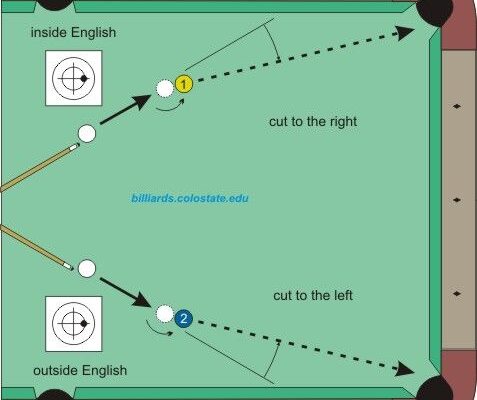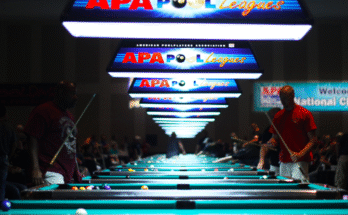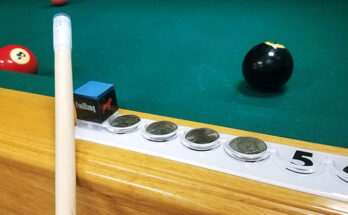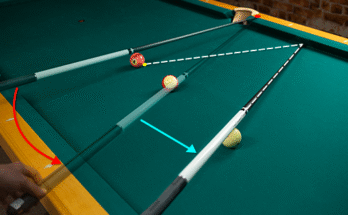Mastering English in Billiards: A Comprehensive Tutorial on Inside and Outside Spin for Cut Shots

In the intricate world of billiards, mastering the application of spin—commonly referred to as “English”—is essential for elevating your game from novice to expert. English allows players to manipulate the cue ball’s path after contact with the object ball, enabling precise position play, enhanced control over deflection, and the ability to navigate complex table layouts. This tutorial, inspired by foundational diagrams from billiards experts at Colorado State University, delves into the mechanics of inside and outside English specifically in the context of cut shots. We’ll break down the concepts step by step, explain the physics involved, provide practical tips for execution, and discuss common pitfalls to avoid. Whether you’re a beginner learning the basics or an intermediate player refining your technique, this guide will equip you with the knowledge to incorporate these spins effectively into your shots.
Understanding the Basics of English in Billiards
Before diving into the specifics of inside and outside English, it’s crucial to grasp what “English” means in billiards. English refers to the side spin imparted on the cue ball by striking it off-center with the cue tip. This spin alters the cue ball’s trajectory post-collision due to friction and deflection forces. There are four primary types of English: left (counterclockwise), right (clockwise), top (follow), and bottom (draw). However, this tutorial focuses on side English (left or right) as it relates to cut shots—angles where the cue ball strikes the object ball at an oblique angle rather than head-on.
The key diagram we’ll reference illustrates two scenarios on a standard pool table:
- Scenario 1 (Top of Diagram): Inside English applied to a cut shot to the right.
- Scenario 2 (Bottom of Diagram): Outside English applied to a cut shot to the left.
In both cases, the cue ball is positioned near the left rail, with the object ball slightly offset. The cue stick approaches from the bottom-left, and arrows depict the pre- and post-contact paths, including the spin-induced curve.
The physics here stem from squirt (cue ball deflection) and throw (object ball deflection):
- Squirt occurs when off-center hits cause the cue ball to veer slightly away from the intended line due to the cue’s mass distribution.
- Throw is the friction-induced deviation of the object ball’s path, amplified by spin.
Proper English compensates for these effects, ensuring accurate pocketing and optimal cue ball positioning for the next shot.
Inside English: Mechanics and Application
Inside English is applied when the spin direction is toward the cut angle—meaning the cue ball spins into the object ball during contact. In the diagram’s top section (labeled “Inside English” with ball marked “1”), we see a cut to the right:
- Setup: The cue ball is struck on the left side (imparting right spin, or clockwise rotation from the player’s perspective).
- Path Visualization: The solid arrow shows the cue ball’s initial path toward the object ball. Upon contact, the right spin “grabs” the object ball, throwing it slightly more to the right than a center-hit would. The dashed arrow indicates the cue ball’s post-contact path, curving outward due to the spin.
- Why It Works: For right cuts, inside English (right spin) reduces squirt, allowing a straighter cue ball line. It also increases throw on the object ball, helping pocket it at sharper angles without overcutting.
Step-by-Step Execution Tutorial:
- Aim Assessment: Align your cue with the ghost ball position (imaginary spot where the cue ball would need to be for a straight shot). For a right cut, visualize the contact point on the object ball’s left side.
- Cue Tip Placement: Position the tip slightly left of center on the cue ball (about 1-2 tips’ width for moderate spin). Use a level cue to minimize unintended elevation.
- Stroke Technique: Deliver a smooth, follow-through stroke with medium speed. Avoid jabbing, as it can miscue or reduce spin accuracy.
- Speed and Angle Considerations: At slower speeds, inside English maximizes throw; at higher speeds, it minimizes deflection. Ideal for thin cuts (e.g., 30-60 degrees).
- Practice Drill: Set up a cue ball and object ball with a 45-degree cut to the corner pocket. Hit 10 shots with inside English, noting how the object ball’s path adjusts compared to no spin.
Advantages: Enhances control in clustered tables, reduces the need for extreme aiming adjustments, and sets up the cue ball for follow-up shots along the rail. Common Mistakes: Over-spinning can cause excessive curve, leading to misses. Always chalk your tip to prevent miscues.
Outside English: Mechanics and Application
Conversely, outside English involves spin away from the cut angle, where the cue ball spins outward from the contact point. In the diagram’s bottom section (labeled “Outside English” with ball marked “2”), this is shown for a cut to the left:
- Setup: The cue ball is struck on the right side (imparting left spin, or counterclockwise rotation).
- Path Visualization: The initial arrow directs the cue ball to the object ball. Post-contact, the left spin causes the cue ball to curve inward (toward the cut direction), while throwing the object ball slightly leftward.
- Why It Works: For left cuts, outside English (left spin) counteracts natural squirt, widening the effective cut angle and allowing the object ball to travel straighter into the pocket.
Step-by-Step Execution Tutorial:
- Aim Assessment: Use the same ghost ball method, but for a left cut, target the object ball’s right side.
- Cue Tip Placement: Offset the tip right of center. Start with minimal offset for beginners to build feel.
- Stroke Technique: Employ a firm, controlled stroke. Pair with follow or draw if needed for position.
- Speed and Angle Considerations: Outside English shines in fuller hits (e.g., 10-30 degrees) and faster shots, where it reduces throw for precision.
- Practice Drill: Mirror the inside English drill but for left cuts. Alternate between outside and no spin to observe differences in cue ball rebound.
Advantages: Ideal for speed control and avoiding scratches, as the outward spin often sends the cue ball away from pockets or obstacles. Common Mistakes: Insufficient spin can lead to undercutting; excessive spin may cause the cue ball to “squirt” too far off-line.
Comparing Inside vs. Outside English: When to Choose Which
To decide between inside and outside English, consider the cut angle and desired cue ball path:
- Inside English: Best for sharper cuts where you need more throw on the object ball. It tends to widen the cue ball’s rebound angle, useful for crossing the table.
- Outside English: Preferred for shallower cuts or when minimizing throw is key. It narrows the rebound, keeping the cue ball closer to the original line.
| Aspect | Inside English | Outside English |
|---|---|---|
| Spin Direction | Toward the cut (e.g., right for right cut) | Away from the cut (e.g., left for right cut) |
| Effect on Throw | Increases object ball deflection | Decreases object ball deflection |
| Effect on Squirt | Reduces cue ball deflection | Increases cue ball deflection |
| Ideal Cut Angle | Thin (30-90 degrees) | Full (0-30 degrees) |
| Cue Ball Path Post-Contact | Wider rebound angle | Narrower rebound angle |
| Common Use Case | Position play across table | Precision pocketing with minimal movement |
Advanced Tips and Physics Insights
For deeper understanding, recall that English leverages friction coefficients between balls and cloth. On a standard slate table with Simonis cloth, spin transfer is about 20-30% efficient. Factors like ball cleanliness, humidity, and cue tip condition affect outcomes—always clean balls before practice.
Incorporate gearing: At certain speeds, outside English can achieve “gearing” where spin matches the relative velocity, eliminating throw entirely for pinpoint accuracy.
Safety and Etiquette: Practice on a dedicated table to avoid wear. In games, declare English use if playing informally to build sportsmanship.
Conclusion: Integrating English into Your Game
By mastering inside and outside English as depicted in this diagram, you’ll unlock advanced shot-making capabilities in billiards. Start with slow, deliberate practice, gradually increasing speed and complexity. Record your sessions to analyze paths, and consult resources like billiards.colostate.edu for more visuals. With consistent application, these techniques will transform your gameplay, leading to higher run-outs and strategic dominance. Remember, billiards is as much about feel as physics—experiment, adapt, and enjoy the cue sport’s elegance.



